Interview with Aymerick Pilarski, AFC, about Abderrahmane Sissako’s "Black Tea"
"Teatime in Abidjan", by François Reumont for the AFCThe film recounts the journey of a woman, but not only that...
Aymerick Pilarski : The film’s point of departure is of course the character Aya, but after having talked about it with Abderrahmane Sissako, his idea was to show very quickly that this woman could represent several aspects of a kind of universal woman. Since his cinema is often made up of tableaux, scenes from life, he began to construct her story by introducing various characters around her who could bring out these different aspects as the story progresses.

Since he’s also someone who likes to be inspired by the location where he is shooting, and who isn’t into over preparing and lets himself follow his intuition, things often changed as the production went on, in function of the actors, and the locations he scouted once on the ground. And as the director of photography, you have to be able to adapt. For example, while we were in the middle of preparations in Taiwan, and shooting was going to start in two weeks, Abderrahmane decided to switch everything to night... except for the only scene at the tea plantation. An artistic decision with a lot of consequences for the organization of the shooting, and of course the lighting equipment we’d need. At first, I wasn’t very sure about this... And then, whenever you shoot a film in Asia, there’s a sort of mantra for every crew where everyone says, "We’re going to figure out a solution !". And I have to say that it was really captivating to completely rethink the work from the perspective of night. First, it enabled us to take better advantage of exterior night scenes, with the extraordinary richness of light in the streets of Taiwan. We immediately started to bring out the entire spectrum of light that we would find on location, all the incandescent bulbs and fluorescent tubes that they sometimes still use there, and then the many LED light sources, with an Astera light kit (tubes and bulbs), and SkyPanels. In the end, I didn’t adjust our lighting budget... it was a real challenge in the end, but we did it !
Did you have to change camera equipment ?
AP : No, because I had had the intuition from the beginning to go with a Sony Venice 2. Its great sensitivity allowed me to adapt to relatively little light, even night exteriors. In fact, that camera had been chosen from the beginning together with Aderrahmane, after we did some comparative tests with the MiniLF, especially because of its color rendering. He wanted something very bright for the film, but at the same time rather soft. That is also why we chose to combine the camera with vintage lenses (Cooke Panchro). And then, as is often the case whenever I work with a director for the first time, I bring along Angénieux zooms just in case to be able to adapt to their style. This decision was particularly helpful for the part in Cape Verde, where we were moving around to a ton of places with little logistical help. It was also an artistic choice to give a bit of a different look for that part of the film. The only little constraint was that since the material came from Luxembourg it was complicated for us to forward the camera to the Ivory Coast then to Cape Verde at the end of the shooting. So, I had to fall back on a Sony Venice 1. This decision was without any real difficulty because the parts shot in these locations are completely separated dramatically from the rest of the film shot in Taiwan.
In what order did you shoot ?
AP : First, we spent seven weeks in Taiwan, of which two were entirely devoted to the exterior locations in "Chocolate City", the African immigrant neighborhood that Aya imagines. The rest of the time spent there was split between other recurring locations (the tea shop, its basement storeroom, the hair salon, the restaurant, and character Cai’s house...) We then left for the Ivory Coast to film the opening sequence and finally Cape Verde. One of the really interesting things was that I got to bring my Taiwanese first AC along for the African part, which allowed him to discover these places and this culture that he had never really had the opportunity to approach. A sort of way of incorporating into the team the theme of cultural mixing that underpins the film !
Your own mastery of Mandarin must have once again been invaluable to you on this film...
AP : Three languages coexisted on set. First, Mandarin, spoken by most of the local crew and by the actors in front of the camera, French, and a bit of English. I was somewhat between the two, which was a pretty advantageous position that allowed me to get information from both sides. As for Abderrahmane, I got the feeling that he wasn’t really hindered by the language barrier he faced with the script. He’s an extremely intuitive person, very much an observer, and knows how to judge in the moment whether we were going in the right direction. Besides, sometimes he really likes to change the lines on set, even if it means disorienting the actors a little bit and directing them towards a kind of natural impromptu. The dinner sequence with the grandparents at the end of the film is a good example. It was originally a scene where the characters had a lot of dialogue, and where he suddenly decided to cut everything down 30 minutes before the take. That decision created a certain uneasiness around the table that worked really well for me in that sequence. To evaluate each take, he also his Taiwanese assistant director who translated most things for him, and then he could also count on me for my opinion on the situation, and on the connection with Chinese culture, and the logic of interactions between the characters on the level of the scene. At the end of each take, in general all three of us (Abderrahmane, the Taiwanese assistant director, and I) looked at one another, then Abderrahmane would decide whether to move on to the next shot or not.
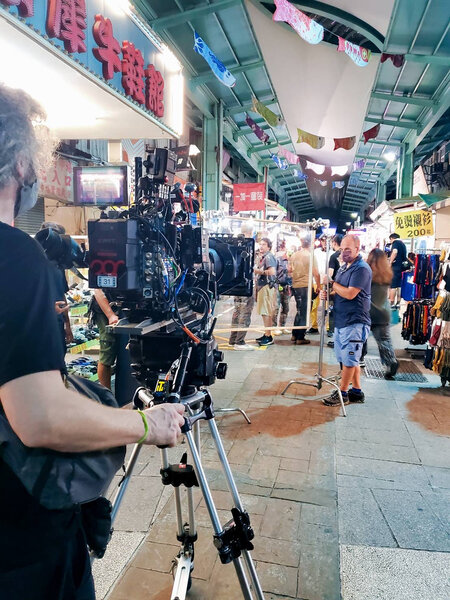
The exterior night sequences that are set in the African neighborhood "Chocolate City" in China are marked by a lot of reflecting effects within the images itself... very deliberate motifs that go beyond simple lens flare !
AP : During our image tests in the days before the shooting – and the famous decision to shoot at night – we immediately noticed that many reflections appeared in many windows and storefronts in natural locations in Taiwan. It’s a visual motif that immediately caught Abderrahmane’s eye and I suggested that we try to take full advantage of it. So much so that several days later, he told me that "Chocolate City" would only exist through reflections in the film. A means for him to break with raw reality and a bring another layer of fantasy and imagination into the story. I then had to develop a particular strategy by getting a large glass frame that the grip and gaffer crews could install in front of the camera to measure out the effect precisely for each shot. Rather heavy set up, but it ended up paying off !
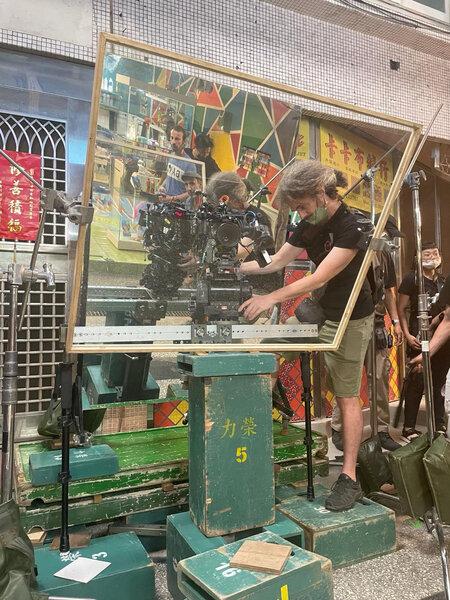
To such an extent that at every new frame, Abderrahmane would say to me : “It looks good... but where are the reflections ?” Every set up became a sort of game of cat and mouse to shoot, succeed in getting the reflections between the window and sources that made them... and to avoid the boom and any unwanted person in the glass, all at the same time. On the location of the hair salon "Treasure", for example, I even remember that the letters on the sign that were reflecting on our window ended up backwards... and it really interfered with the legibility of the image. We had to add another mirror to reverse the whole thing. There, it was getting almost comical to see the tiny camera surrounded by this enormous apparatus of equipment with a whole mess of glass around it... A real artistic gamble, with no way of going back. Aderrahmane justified this decision by telling me that when you take that kind of artistic stance on a film, only radicality works.
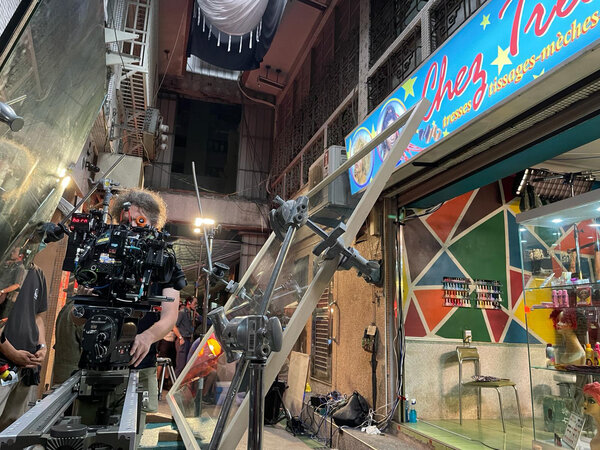
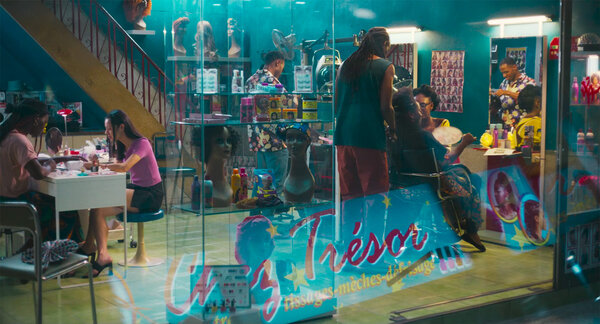

The romance between Aya and Cai mostly takes place in the subdued setting of the teashop basement. Let’s talk a bit about those sequences, one of which became the image for the poster...
AP : The tea ceremony in this basement location is indeed a key moment. It returns several times in the film. During preparation, Abderrahmane was able to attend these kinds of ceremonies, performed by masters, and he found their gestures so beautiful that he absolutely wanted to portray them in such a way that replicated each gesture that contributed to the poetry of the story. Also, we decided to cover these scenes from several camera angles with very different qualities. It turned out that for reasons of the availability of the location, we had to start by shooting these scenes. Given the importance of these moments for the film, it wasn’t really a thing that would occur to anyone on a classic shooting schedule. But in retrospect, it wasn’t such a bad thing... These scenes in the storeroom of the shop immersed everyone in the essence of the film, and in the heart of the relationship between our two protagonists.
In what conditions did you shoot these scenes ?
AP : In a fake studio, recreating the basement on the fourth floor of a building in an abandoned space. This decision allowed us to control the layout of the place exactly, and notably the relation with the stairway that leads up to the ground floor of the store in the film. The ceiling height also allowed us to film more easily, like for the high angle wide shot. As for lighting, the decision was made in prep for a single lightbulb hanging from the ceiling, installed by set design. We just created that effect with a soft Top Light in the shot/reverse shot, taking care to maintain the contrast with the backgrounds as much as possible, at the director’s request.
This dim lighting was accentuated even more as we return to this setting over the course of the film.
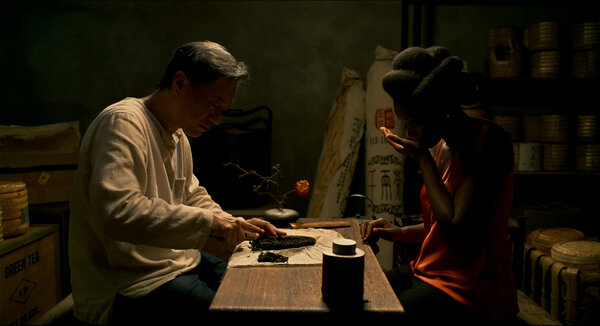
What will you take away from this first experience between Africa and Asia ?
AP : Knowing how to adapt and be flexible. It’s something that I have often put into practice on shoots in China and that was necessary on Black Tea. You find yourself on a film like this one, you realize that there are a lot of bridges between those two worlds in the end. In Abderrahmane’s approach, for example, I recognized the tendency of some Chinese directors who don’t necessarily want to project mentally before they find themselves on set with the team. There is really this idea of living in the present moment, common to both cultures. On a Chinese set, for example, you are often struck by their ease in improvisation and their "never give up" mentality. And I found exactly that joyful and positive ambiance in the African part of the film. Also, I really enjoyed the opportunity to work with a second Ivorian camera operator on the sequence with the wedding. It allowed me to better observe how people make films there too. I think at the end of shooting I was a little disoriented, a bit like when you do a kind of world tour in fast forward.
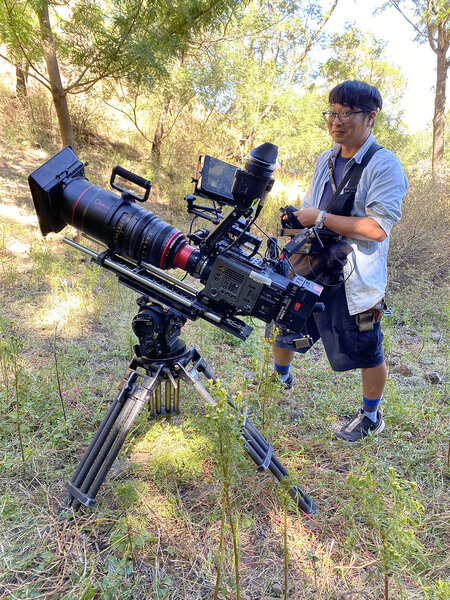
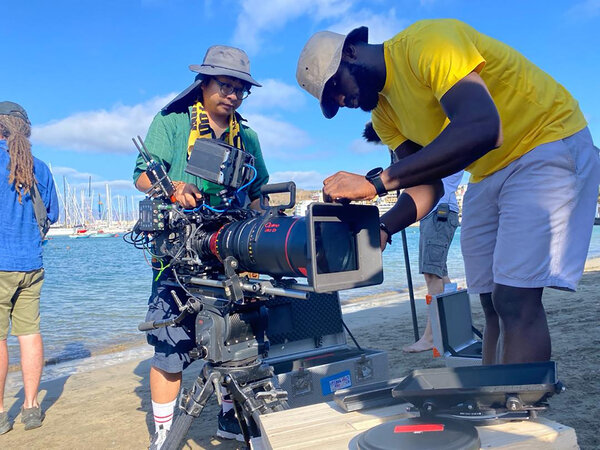
(Interview conducted by François Reumont for the AFC, and translated from French by Alexander B. Raiffe)
Black Tea
Aya, a young, Ivorian woman about thirty years old says no on the day of her wedding, to the surprise of everyone. Immigrant in China, she works in a tea export shop with Cai, a 45-year-old Chinese man. Aya and Cai fall in love, but will their story survive their tumultuous pasts and others’ prejudices ?
Director : Abderrahmane Sissako
Director of Photography : Aymerick Pilarski, AFC
Set Design : Véroique Sacrez
Costumes : Annie Melza Tiburce
Sound : Carlo Thoss
Editing : Nadia Ben Rachid
Music : Armand Amar
 En
En Fr
Fr






